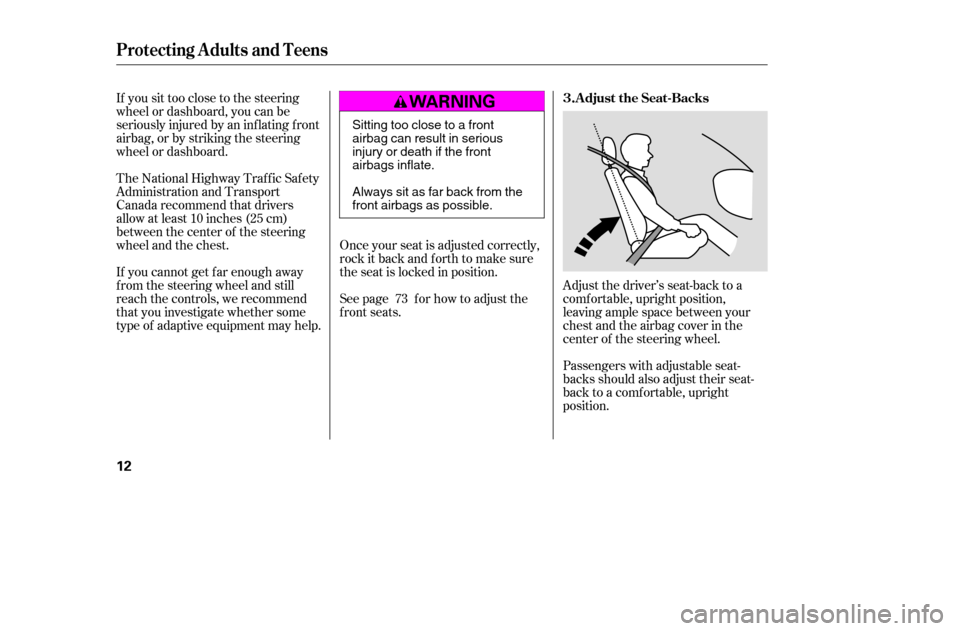Page 7 of 226
Always wear
your seat belt properly, and sit
upright and as f ar back f rom the
steering wheel as possible while
allowing f ull control of the vehicle. A
f ront passenger should move their
seat as far back from the dashboard
as possible. The rest of this section gives more
detailed inf ormation about how you
can maximize your saf ety.
Remember, however, that no saf ety
system can prevent all injuries or
deaths that can occur in a severe
crash, even when seat belts are
properly worn and the airbags deploy.
Your Vehicle’s Saf ety Features
What you should do:
10
�����—�����—�����y�
���������
���y���
�(���%�������y�����
���y
Page 9 of 226

If you sit too close to the steering
wheel or dashboard, you can be
seriously injured by an inf lating f ront
airbag, or by striking the steering
wheel or dashboard.
The National Highway Traffic Safety
Administration and Transport
Canada recommend that drivers
allow at least 10 inches (25 cm)
between the center of the steering
wheel and the chest.
If you cannot get f ar enough away
f rom the steering wheel and still
reach the controls, we recommend
that you investigate whether some
type of adaptive equipment may help.Once your seat is adjusted correctly,
rock it back and f orth to make sure
the seat is locked in position.
See page f or how to adjust the
f ront seats.
Adjust the driver’s seat-back to a
comf ortable, upright position,
leaving ample space between your
chest and the airbag cover in the
center of the steering wheel.
Passengers with adjustable seat-
backs should also adjust their seat-
back to a comf ortable, upright
position.
73
Protecting A dults and Teens
Adjust the Seat-Backs
3.
12
Sitting too close to a front
airbag can result in serious
injury or death if the front
airbags inflate.
Always sit as far back from the
front airbags as possible.
�����—�����—�����y�
�������������y���
�(���%�������y�����
���y
Page 18 of 226

Your airbag system includes:Automatic front seat belt
tensioners (see page ). In models with side airbags, an
indicator on the instrument panel
that alerts you that the passenger’s
side airbag has been turned of f
(see page ).
Emergency backup power in case
your vehicle’s electrical system is
disconnected in a crash.
Two SRS (Supplemental Restraint
System) f ront airbags. The driver’s
airbag is stored in the center of
the steering wheel; the f ront
passenger’sairbagisstoredinthe
dashboard. Both are marked ‘‘SRS
AIRBAG’’ (see page ).
In models with side airbags, one
for the driver and one for a front
passenger. The airbags are stored
in the outer edges of the seat-
backs. Both are marked ‘‘SIDE
AIRBAG’’ (see page ). Sensors that can detect a
moderate to severe front impact,
or side impact in models with side
airbags.
In models with side airbags,
sensors that can detect whether a
small person or child is in the
passenger’s side airbag path and
automatically turn the airbag off
(see page ).
An indicator on the instrument
panel that alerts you to a possible
problem with your airbags,
sensors, or seat belt tensioners
(see page ).
A sophisticated electronic system
that continually monitors and
records inf ormation about the
sensors, the control unit, the
airbag activators, the seat belt
tensioners, and driver and f ront
passenger seat belt use when the
ignition is ON (II).
22 24
19 26
25
25
A irbag System Components
Additional Inf ormation About Your Airbags
Driver and Passenger Saf ety
21
�����—�����—�����y�
�������������y���
�(���%�������y���������y
Page 26 of 226
�µ
To remind you of the passenger’s
f ront airbag hazards, and that
children must be properly restrained
in a back seat, your vehicle has
warninglabelsonthedashboard
(U.S. models) and on the f ront visors.
Please read and follow the
instructions on these labels.U.S. ModelsCanadian Models
Protecting Children General Guidelines
Driver and Passenger Saf ety
29
SUN VISOR
SUN VISOR
DASHBOARD
�����—�����—�����y�
�������������y���
�(���%�������y���������y
Page 27 of 226

�µ
Many parents say they pref er to put
an inf ant or small child in the f ront
passenger seat so they can watch the
child, or because the child requires
attention.
Placing a child in the f ront seat
exposes the child to hazards in a
f rontal collision, and paying close
attention to a child distracts the
driver from the important tasks of
driving, placing both of you at risk.
Your vehicle has a back seat where
children can be properly restrained.
If you ever have to carry a group of
children, and a child must ride in
front:
Place the largest child in the f ront
seat, provided the child is large
enough to wear the lap/shoulder
belt properly (see page ).
Move the vehicle seat as far to the
rear as possible (see page ).
Have the child sit upright and well
backintheseat(seepage ).
Make sure the seat belt is properly
positioned and secured (see page ). If a child requires close physical
attention or f requent visual contact,
we strongly recommend that another
adult ride with the child in a back
seat. The back seat is far safer for a
child than the front. If you are not wearing a
seat belt in a crash, you could be
thrown f orward and crush the
child against the dashboard or a
seat-back. If you are wearing a
seat belt, the child can be torn
from your arms and be seriously
hurt or killed.
During a crash, the
belt could press deep into the child
and cause serious or fatal injuries.
If they do, they
could be very seriously injured in a
crash.
41
73
15
14
If You Must Drive with Several
Children
If a Child Requires Close
AttentionAdditional Saf ety Precautions
Protecting Children General Guidelines
Neverholdaninfantorchildon
your lap.
Never put a seat belt over yourselfand a child.
Never let two children use thesame seat belt .
30
�����—�����—�����y�
�����������
�y���
�(���%�������y���������y
Page 43 of 226
These labels are in the locations
shown. They warn you of potential
hazards that could cause serious
injury. Read these labels caref ully.
If a label comes of f or becomes hard
to read (except for the U.S.
dashboard label which may be
removed by the owner), contact your
dealer f or a replacement.U.S. modelsCanadian models
U.S. models only
Saf ety L abels
46
RADIATOR CAP SUN VISOR
DASHBOARD
�����—�����—�����y�
�����������
�y���
�(���%�������y���������y
Page 75 of 226
If equipped
The moonroof can be tilted up in the
back f or ventilation, or it can be slid
back into the roof. Use the switch
under the lef t dashboard vent to
operate the moonroof . You must
turn the ignition switch to ON (II)
f or the moonroof to operate.To tilt up the back of the moonroof ,
press and hold the center button
( ). To close the moonroof ,
press and hold the top of the switch
( ). To open the moonroof ,
press and hold the bottom of the
switch ( ).
Moonroof
Inst rument s and Cont rols
79
MOONROOF SWITCH
TILT BUTTON
Opening or closing the
moonroof on someone’s hands
or fingers can cause seriousinjury.
Make sure all hands and fingers
are clear of the moonroof
before opening or closing it. If you try to open the moonroof in
below-f reezing temperatures, or when
it is covered with snow or ice, you can
damage the moonroof panel or motor.
�����—�����—�����y�
�������������y���
�(���%�������y���������y
Page 84 of 226

Air f lows f rom the def roster
vents at the base of the windshield. Air flows from the center
and corner vents in the dashboard.
The outside air intakes f or the
heating and cooling system are at
the base of the windshield. Keep this
area clear of leaves and other debris.
Switch to recirculation mode when
driving through dusty or smoky
conditions, then return to fresh air
mode.
This button turns the rear window
def ogger of f and on (see page ).
Turning this dial clockwise increases
the temperature of the airflow.
This button turns the air
conditioning on and of f . The
indicatorinthebuttonisonwhen
the A/C is on.
Use the mode control dial to select
the vents the air flows from. Some
air will f low f rom the dashboard
corner vents in all modes. Airf low is divided between
the vents in the dashboard and the
f loor vents.
Airf low is divided between
the f loor vents and the def roster
vents at the base of the windshield.
When you select or ,
the system automatically switches to
f resh air mode and turns on the A/C.
You cannot turn the A/C of f in this
mode.
Turn this dial to increase or decrease
the fan speed and airflow.
When the recirculation indicator is
on, air f rom the vehicle’s interior is
sent throughout the system again.
When the indicator is off, air is
brought in f rom the outside of the
vehicle (fresh air mode).
Thesystemshouldbeleftinfresh
air mode under almost all conditions.
Keeping the system in recirculation
mode, particularly with the A/C of f ,
can cause the windows to fog up.
Air f lows f rom the f loor
vents. When you select , the
system automatically switches to
f resh air mode.
64
Optional on DX and HX models
Rear Window Def ogger Button
Mode Control Dial
Fan Control Dial
A irf low Controls
T emperature Control Dial
Air Conditioning (A/C) Button
Recirculation Button
Vents, Heating, and A/C
Features
89
�����—�����—�����y�
���������
���y���
�(���%�������y���������y